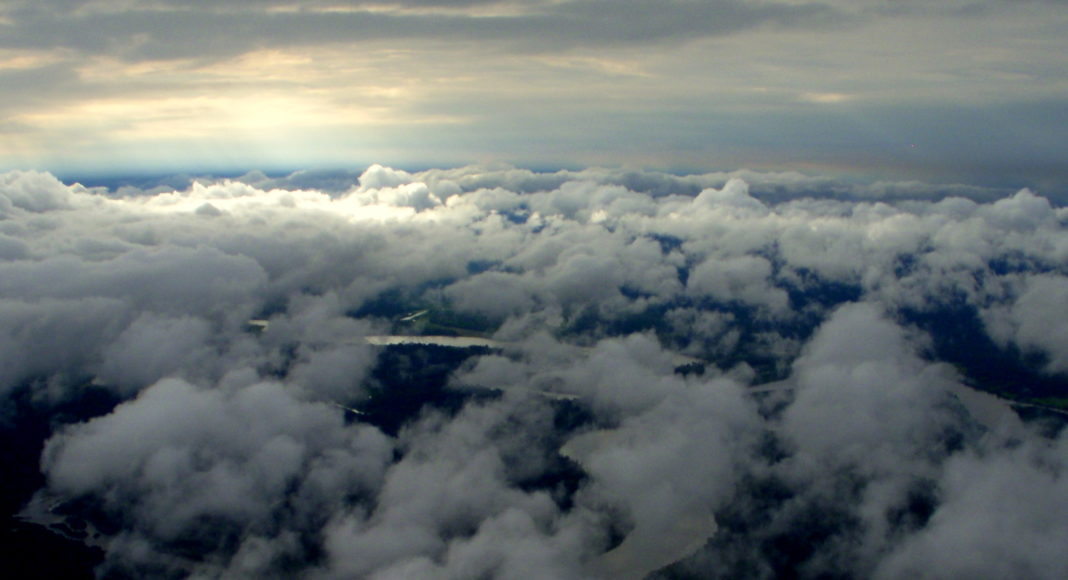Scientists in Brazil believe the loss of billions of litres of water released as vapour clouds by Amazon rainforest trees is the result of continuing deforestation and climate change – leading to devastating drought.
The unprecedented drought now affecting São Paulo, South America’s giant metropolis, is believed to be caused by the absence of the “flying rivers” − the vapour clouds from the Amazon that normally bring rain to the centre and south of Brazil.
Some Brazilian scientists say the absence of rain that has dried up rivers and reservoirs in central and southeast Brazil is not just a quirk of nature, but a change brought about by a combination of the continuing deforestation of the Amazon and global warming.
This combination, they say, is reducing the role of the Amazon rainforest as a giant “water pump”, releasing billions of litres of humidity from the trees into the air in the form of vapour.
Meteorologist Jose Marengo, a member of the Intergovernmental Panel on Climate Change, first coined the phrase “flying rivers” to describe these massive volumes of vapour that rise from the rainforest, travel west, and then − blocked by the Andes − turn south.
Satellite images from the Centre for Weather Forecasts and Climate Research of Brazil’s National Space Research Institute (INPE) clearly show that, during January and February this year, the flying rivers failed to arrive, unlike the previous five years.
 Latest figures from Deter, the Real Time Deforestation Detection System based on high frequency satellite images used by INPE, show that, after falling for two years, Amazon deforestation rose again by 10% between August 2013 and July 2014. The forest is being cleared for logging and farming.
Tocantins, Pará and Mato Grosso, three states in the Greater Amazon region that have suffered massive deforestation, are all registering higher average temperatures.
As long ago as 2009, Antonio Nobre, one of Brazil’s leading climate scientists, warned that, without the “flying rivers”, the area that produces 70% of South America’s GNP would be desert.
In an interview with the newspaper Valor, he said: “Destroying the Amazon to advance the agricultural frontier is like shooting yourself in the foot. The Amazon is a gigantic hydrological pump that brings the humidity of the Atlantic Ocean into the continent and guarantees the irrigation of the region.”
“Of course, we need agriculture,” he said. “But without trees there would be no water, and without water there is no food.
“A tonne of soy takes several tonnes of water to produce. When we export soy we are exporting fresh water to countries that don’t have this rain and can’t produce. It is the same with cotton, with ethanol. Water is the main agricultural input. If it weren’t, the Sahara would be green, because it has extremely fertile soil.”
Latest figures from Deter, the Real Time Deforestation Detection System based on high frequency satellite images used by INPE, show that, after falling for two years, Amazon deforestation rose again by 10% between August 2013 and July 2014. The forest is being cleared for logging and farming.
Tocantins, Pará and Mato Grosso, three states in the Greater Amazon region that have suffered massive deforestation, are all registering higher average temperatures.
As long ago as 2009, Antonio Nobre, one of Brazil’s leading climate scientists, warned that, without the “flying rivers”, the area that produces 70% of South America’s GNP would be desert.
In an interview with the newspaper Valor, he said: “Destroying the Amazon to advance the agricultural frontier is like shooting yourself in the foot. The Amazon is a gigantic hydrological pump that brings the humidity of the Atlantic Ocean into the continent and guarantees the irrigation of the region.”
“Of course, we need agriculture,” he said. “But without trees there would be no water, and without water there is no food.
“A tonne of soy takes several tonnes of water to produce. When we export soy we are exporting fresh water to countries that don’t have this rain and can’t produce. It is the same with cotton, with ethanol. Water is the main agricultural input. If it weren’t, the Sahara would be green, because it has extremely fertile soil.”
Alarming proportions
Deforestation all over Brazil has reached alarming proportions: 22% of the Amazon rainforest (an area larger than Portugal, Italy and Germany combined), 47% of the Cerrado in central Brazil, and 91.5% of the Atlantic forest that used to cover the entire length of the coastal area. Latest figures from Deter, the Real Time Deforestation Detection System based on high frequency satellite images used by INPE, show that, after falling for two years, Amazon deforestation rose again by 10% between August 2013 and July 2014. The forest is being cleared for logging and farming.
Tocantins, Pará and Mato Grosso, three states in the Greater Amazon region that have suffered massive deforestation, are all registering higher average temperatures.
As long ago as 2009, Antonio Nobre, one of Brazil’s leading climate scientists, warned that, without the “flying rivers”, the area that produces 70% of South America’s GNP would be desert.
In an interview with the newspaper Valor, he said: “Destroying the Amazon to advance the agricultural frontier is like shooting yourself in the foot. The Amazon is a gigantic hydrological pump that brings the humidity of the Atlantic Ocean into the continent and guarantees the irrigation of the region.”
“Of course, we need agriculture,” he said. “But without trees there would be no water, and without water there is no food.
“A tonne of soy takes several tonnes of water to produce. When we export soy we are exporting fresh water to countries that don’t have this rain and can’t produce. It is the same with cotton, with ethanol. Water is the main agricultural input. If it weren’t, the Sahara would be green, because it has extremely fertile soil.”
Latest figures from Deter, the Real Time Deforestation Detection System based on high frequency satellite images used by INPE, show that, after falling for two years, Amazon deforestation rose again by 10% between August 2013 and July 2014. The forest is being cleared for logging and farming.
Tocantins, Pará and Mato Grosso, three states in the Greater Amazon region that have suffered massive deforestation, are all registering higher average temperatures.
As long ago as 2009, Antonio Nobre, one of Brazil’s leading climate scientists, warned that, without the “flying rivers”, the area that produces 70% of South America’s GNP would be desert.
In an interview with the newspaper Valor, he said: “Destroying the Amazon to advance the agricultural frontier is like shooting yourself in the foot. The Amazon is a gigantic hydrological pump that brings the humidity of the Atlantic Ocean into the continent and guarantees the irrigation of the region.”
“Of course, we need agriculture,” he said. “But without trees there would be no water, and without water there is no food.
“A tonne of soy takes several tonnes of water to produce. When we export soy we are exporting fresh water to countries that don’t have this rain and can’t produce. It is the same with cotton, with ethanol. Water is the main agricultural input. If it weren’t, the Sahara would be green, because it has extremely fertile soil.”

